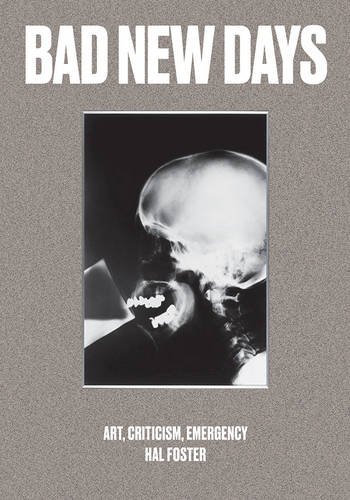Hal Foster: Bad New Days: Art, Criticism, Emergency (2015)
Filed under book | Tags: · abject, aesthetics, archive, art, art criticism, art history, critique, dialectic, fetish, mimesis, neoliberalism, poststructuralism, precarity, theory

“Bad New Days examines the evolution of art and criticism in Western Europe and North America over the last twenty-five years, exploring their dynamic relation to the general condition of emergency instilled by neoliberalism and the war on terror.
Considering the work of artists such as Thomas Hirschhorn, Tacita Dean, and Isa Genzken, and the writing of thinkers like Jacques Rancière, Bruno Latour, and Giorgio Agamben, Hal Foster shows the ways in which art has anticipated this condition, at times resisting the collapse of the social contract or gesturing toward its repair; at other times burlesquing it.
Against the claim that art making has become so heterogeneous as to defy historical analysis, Foster argues that the critic must still articulate a clear account of the contemporary in all its complexity. To that end, he offers several paradigms for the art of recent years, which he terms “abject,” “archival,” “mimetic,” and “precarious.””
Publisher Verso, London and New York, 2015
ISBN 1784781460, 9781784781460
208 pages
Presentation and discussion (video, The Kitchen, NYC, Sep 2015)
Interview (John Douglas Millar, Mute, Nov 2015)
Reviews: Mark Steven (Affirmations 2015), Brian Dillon (Guardian 2015), Rachel Wetzler (ArtNews 2015).
Comment (1)Bojana Cvejić, Goran Sergej Pristaš (eds.): Parallel Slalom: A Lexicon of Non-aligned Poetics (2013)
Filed under book | Tags: · aesthetics, cinema, contemporary art, dance, east-central europe, non-aligned movement, performance, poetics, theatre, theory, yugoslavia
![]()
“What does it take to create one’s own concepts? What does it mean to own a concept? Parallel Slalom is an edited collection of essays that attempt to address these questions from the viewpoint of artistic and theoretical practices that have been developing since the 1960s, especially in the period after the breakup of Yugoslavia in 1991. Artists, dramaturges, theorists, editors, writers or ‘cultural workers’ who write or are written about in this volume don’t always belong to the same historical, geopolitical and cultural framework that the curator Ješa Denegri called, the ‘common Yugoslav cultural space’ also because a considerable number of writers come from contexts other than those in Eastern Europe. Yet they share a kind of thought that arises from within, or close to, artistic practice as a poetical instrument of looking past art into the production of political, social and aesthetic realms.”
“Among the concepts developed are: Americanism; artivisim; acting without publicizing; Chaplinism; cinema clubs; cinematic modes of action; contextual art; delay; delayed audience; digitality; East Dance Academy; generations; group sex; laziness; operation; politics of affection and uneasiness; proceduralism; protocol; radical amateurism; reconstruction, second-hand-knowledge; slideshow; temporary zones, shelters, and project spaces; tiger’s leap into history; unburdened, aesthetically; unlearned, terminally.”
Contributions by Ric Allsopp, Jonathan Beller, Ivana Bago, Bojana Cvejić, Isabel de Naveran, Tomislav Gotovac, Owen Hatherley, Ana Janevski, Janez Janša, Marko Kostanić, Bojana Kunst, Antonia Majača, Aldo Milohnić, Goran Sergej Pristaš, Mårten Spångberg, Mladen Stilinović, Miško Šuvaković, Terminally Unschooled, Terms study group, and Ana Vujanović.
Publisher Walking Theory ‒ TkH, Belgrade, and CDU – Centre for Drama Art, Zagreb, 2013
ISBN 8690589961, 9788690589968
411 pages
via Academia.edu
Publisher (TkH)
Publisher (CDU)
WorldCat
PDF (7 MB)
Comment (0)Max Bense: aesthetica IV. Programmierung des Schönen. Allgemeine Texttheorie und Textästhetik (1960) [German]
Filed under book | Tags: · aesthetics, information theory, literary theory, statistics, text, theory

“Max Benses informationeile Ästhetik schließt mit einer Allgemeinen Texttheorie ab, die, auf der Grundlage statistischer Untersuchungen von Fucks, Herdan, Mandelbrot u. a., als Modell der neuen statistischen Zeichen-Ästhetik aufgefaßt werden kann.
Die Allgemeine Texttheorie bezieht sich auf jede Art von Text, schließt also die ästhetische Theorie der Poesie und Prosa, aber auch der wissenschaftlichen Sprachen, Werbesprachen und abstrakten Sprachen usw. ein.
Der Begriff Text wird dabei als derjenige sprachliche Zustand aufgefaßt, der statistische bzw. informationelle, semantische bzw. ästhetische Formen meint, aus deren Materialität Poesie und Prosa im klassischen Sinne erst hervorgehen. Der Begriff Text zielt also nicht auf vorästhetische Zustände der Sprache ab, sondern auf vorpoetische und vorprosaische. Er bestimmt gewissermaßen die archaischen theoretischen Fundamente der Literatur.
Allgemeine Texttheorie umfaßt also Textstatistik, Textsemantik, Textphänomenologie und Textästhetik. Der bisher völlig unklar oder falsch verwendete Ausdruck Logik der Dichtung verschwindet zugunsten des genau formulierbaren Ausdrucks Textsemantik, der den Begriff Textlogik mit umfaßt.
Es werden also sowohl numerische wie essentielle Überlegungen zum Begriff Text angestellt.
Die Allgemeine Texttheorie erscheint als Grundlagenforschung für zukünftige Literaturwissenschaft und Literaturtheorie. Sie will exakte Mittel einführen und der beliebigen üblichen Interpretation, soweit sie nicht historische Fakten herausstellt, ein Ende bereiten.” (from the dusk jacket)
Publisher Agis, Baden-Baden and Krefeld, 1960
128 pages
via Mitchell Johnson
Commentary: Reinhard Döhl (n.d., DE).
Comment (1)
